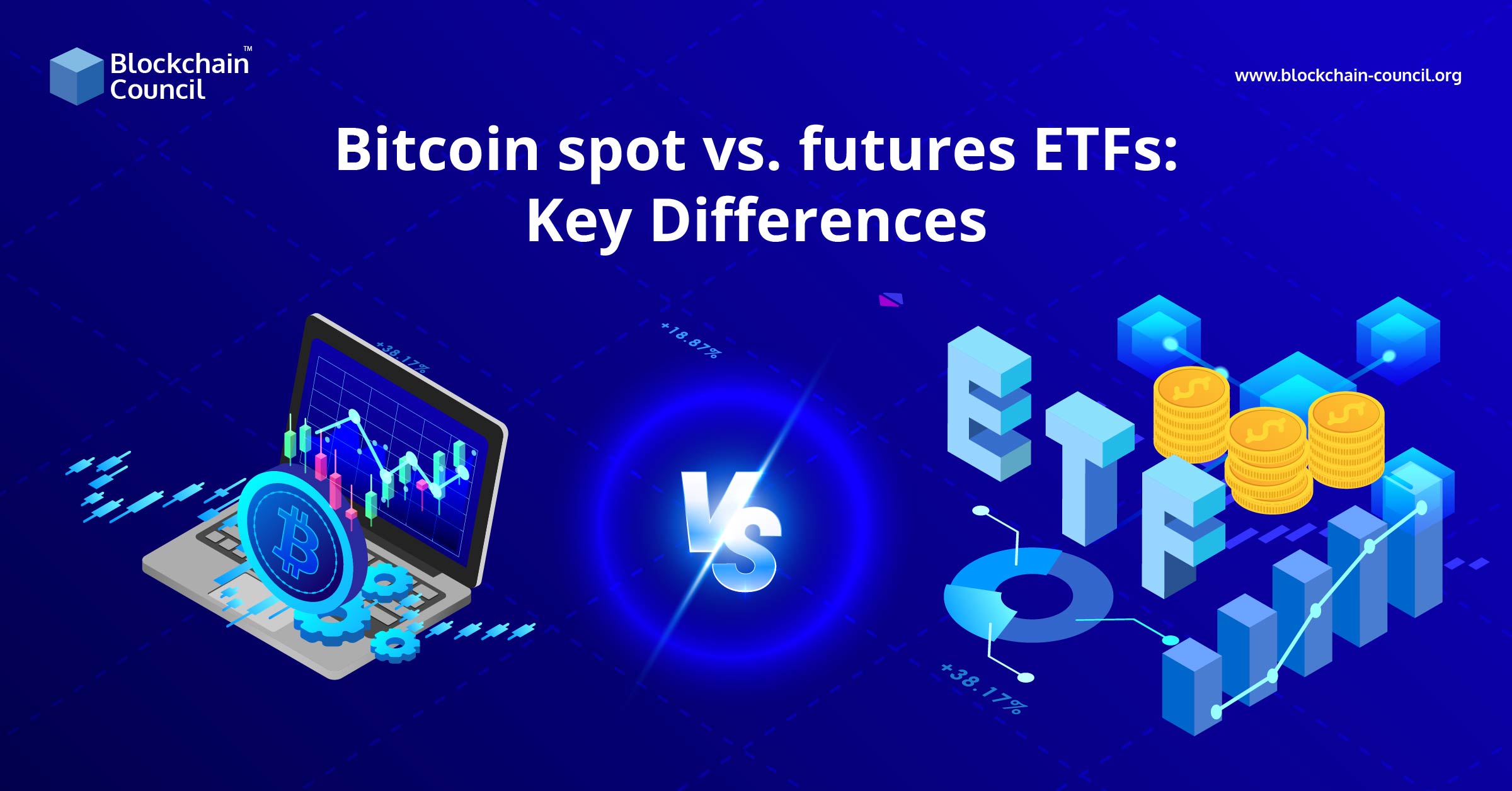
- Blockchain Council
- February 08, 2024
The New York Stock Exchange launched the very first Bitcoin futures ETF in the United States. However, the investors are in a dilemma about how it differs from a spot-based ETF.
So here we are, to examine the distinctions between Bitcoin spot and futures ETFs as ProShares’ Bitcoin futures ETF debuts on the New York share market Exchange.
What do you mean by Bitcoin ETF?
A Bitcoin exchange-traded fund (ETF) enables investors to buy Bitcoin without actually purchasing the currency. This investing approach simplifies the purchasing procedure by eliminating the need for customers to join up for a crypto exchange or interact with crypto wallets.
An ETF is a type of conventional investment that monitors the value of an investment or a collection of securities. ETFs are a convenient method to participate in several assets at the same time without actually possessing those holdings.
While considering Bitcoin, a Bitcoin ETF is essentially a holding that measures the value of Bitcoin. Consumers may benefit from Bitcoin’s growth by participating in a Bitcoin ETF without riding the process of purchasing Bitcoin, including signing up for an exchange and passing through several forms of identification and authentication.
However, the Bitcoin ETF is rather restricted within itself. The initial Bitcoin ETF, the ProShares Bitcoin Strategy ETF (BITO), was made available in the marketplace in October 2021. However, rather than investing directly in the asset, this ETF invests in Bitcoin commodity futures as a substitute.
What do you mean by Bitcoin futures ETF?
Most of the Bitcoin futures ETFs keep the Bitcoin futures contracts. Consumers may wager on the price of Bitcoin using futures contracts, which require them to commit to purchase or sell Bitcoin at a predetermined rate on a specific date.
A Bitcoin futures ETF, according to crypto experts, is an exchange-traded asset that contains Bitcoin futures contracts, which are contracts in which one buys or sells Bitcoin at a specific price on a specific date.
For instance, when purchasing via the ProShares Bitcoin Strategy ETF, a trader is trading his/her funds that hold futures contracts. Although, the ETF allows investors to bypass trading in futures themselves, and in lieu the investors can exchange BITO similar to a conventional stock.
Futures contracts are typically used for speculation or hedging as per bitcoin specialists. However, in the absence of ProShares, users might just acquire any quantity of Bitcoin at any time, but a futures ETF confirms that consumers may trade in virtual currencies and Bitcoin futures contracts without having to deal through exchange platforms.
But in comparison to most cryptocurrency exchanges, this technique also has lower fees. Nevertheless, because a futures ETF does not include investment in Bitcoin at its spot price, some supporters may not regard the offering to be a “genuine” cryptocurrency uptake.
Furthermore, organizations that provide a Bitcoin futures ETF may demand yearly fees, leaving many investors looking for a substitute ETF to invest.
How does a Bitcoin ETF work?
A spot Bitcoin ETF has the same simplified investment possibilities as a Bitcoin futures ETF, yet it enables customers to engage at the current price of Bitcoin instead of being at a potential value.
A spot Bitcoin ETF provides all of the advantages of a futures ETF, including the decision to spend in Bitcoin without deploying an exchange, paying lower transactional fees than on a cryptocurrency exchange platform, and streamlining the process altogether. A spot ETF, on the other hand, trades in Bitcoin just at the moment.
That’s true, a spot ETF buys in Bitcoin at its current price, implying that purchasers would be owning Bitcoin within the financing, much like they would purchase a stock. Since a spot ETF entail owning Bitcoin, supporters consider it a more credible means of trading.
Nevertheless, given the fledgling nature of the business, there is currently no concept of a Bitcoin spot ETF. Crypto industry experts frequently push for a business to build a Bitcoin spot ETF because they feel that once a spot ETF is launched, traders will take Cryptocurrencies significantly.
How ETFs Are Regulated
While crypto supporters applauded the SEC’s approval of a Bitcoin futures ETF, many criticized the agency’s refusal to authorize a Bitcoin spot ETF. Since 2013, the SEC has rejected scores of petitions with no strong demonstration that it plans to modify its approach. The evident distinction between futures-based and physical ETFs might explain the decision.
One of the most significant distinctions between the two kinds of ETFs is the regulatory structure since they both follow separate paths. Physical ETFs are governed by the 1933 Securities Act, which requires exchanges to provide a Form 19b-4 to prove that the fundamental industry is not manipulated. Futures-based ETFs, on the other hand, are governed by the 1940 Investment Company Act and do not need the same structure.
Crypto spot markets are mostly unregulated, although futures market laws provide some certainty for traders. The Commodity Futures Trading Commission established the regulations for ProShares’ Bitcoin futures trading.
The participation of the CFTC as a federal regulator in the spot market may reflect why and how the SEC has been amenable to ETFs, like the one created by ProShares. However, because there is no national set of regulations for the spot cryptocurrency industry, proposals for spot Bitcoin ETFs have been regularly refused.
The fight for a Bitcoin spot ETF
The Bitcoin spot ETF still does not exist, despite crypto firms submitting different designs to the Securities and Exchange Commission (SEC) throughout the years. Nevertheless, a few businesses have given the Bitcoin futures ETF legitimacy.
For years, crypto companies have lobbied for the SEC to legalise a Bitcoin spot ETF in the United States, but despite the appointment of two apparently crypto-friendly chairman, the SEC has refused to budge.
For example, Jay Clayton, the SEC’s chairman from May 4, 2017, until December 23, 2020, supports Bitcoin as a measure of value. No suggestion, however, persuaded Clayton that a Bitcoin ETF of any type was ready. However, because BITO is incorporated underneath the Investment Company Act of 1940, it does not need express clearance from the SEC to begin operations.
In any case, ProShares’ BITO was allowed by Clayton’s successor, Gary Gensler. Several ETF applications have been approved, including some from Valkyrie and Van Eck. Grayscale, on the other hand, might be the first company to launch a Bitcoin spot exchange-traded fund (ETF).
Grayscale, the owner of the globe’s first SEC-approved, publicly listed Grayscale Bitcoin Trust (GBTC), submitted a Bitcoin spot ETF to the SEC in 2016. Due to an impasse in the conversation, the organization withdrew its request in 2017. GBTC, like BITO, does not specifically require SEC clearance to start the business.
Rather, GBTC is now available to authorized investors, and shares can be exchanged on the open market following a certain storage time.
According to certified bitcoin experts, Grayscale appears determined to transform GBTC into the world’s first Bitcoin spot ETF by March 2022, even wanting to charge the SEC if its current venture fails. In response, the SEC says that market speculation is the most significant impediment to licensing a Bitcoin spot ETF.
Bitcoin Spot vs. Bitcoin Futures ETFs
A Bitcoin spot ETF would provide many ordinary traders with high contact with the market without the trouble and difficulty of obtaining and holding it in a digital wallet. Financial advisers manage 40% of all assets in the United States, as per Bitwise Invest CIO Matt Hougan. They are not advised to trade in bitcoins on behalf of the shareholders under existing legislation. As a result, since many have hailed the creation of the very first Bitcoin futures ETF, a spot fund with Bitcoin coverage would potentially be a more powerful stimulus for the asset’s institutionalization.
Futures-based ETFs are distinguished by the fact that they provide traders with accessibility to futures contracts rather than any securities. Futures contracts are legally binding agreements to acquire or sell a product, asset, or investment at a fixed price at a pre-defined date. They have a distinct risk level than spot trading.
In contrast to monitoring the spot market value of the underlying commodity, a futures-based ETF follows futures contracts via the CME-listed futures markets. As a result, the value of the ProShares ETF will differ from the value of cryptocurrency. Furthermore, with income futures, neither of the financial funds change hands (i.e., there is no on-chain BTC trading).
CME Bitcoin futures are cash-settled and are meant to reflect the CME CF Bitcoin Reference Rate (BRR), a measure of inflation calculated on the basis of the trading price of numerous BTC exchanges, such as Bitstamp, Coinbase, Gemini, itBit, and Kraken and many more. Cryptocurrency developer states that every futures contract has a termination period, and contracts in BTC are posted for six months in a row.
Investors sometimes roll over futures contracts by trading someone whose expiry dates are nearing and then purchasing others whose deferrals are several months away. This turnover comes at a cost, as well as what is more referred to simply as contango (i.e. when the futures rates of an asset increase more than the anticipated spot rate at a similar moment in the future).
The fees and price monitoring concerns would be eliminated by a Bitcoin spot ETF related to futures contracts. It would also be a more straightforward offering for the commercial sector. Nevertheless, until the SEC modifies its stance, Bitcoin futures ETFs will be the nearest accessible equivalent commodity on the financial markets.
The debut of the first Bitcoin futures ETF has generated discussion about the possible effect on the cryptocurrency space and how an ETF allowing significant exposure to Bitcoin might alter the environment. Many people feel that a spot Bitcoin ETF would be a major step ahead for the sector. While this is true, it’s difficult to defend that Bitcoin futures ETFs won’t be a net positive to the sector because they enhance popular crypto publicity and requirement for liquidity owing to corporate futures contracts.
How many Bitcoin ETFs are there?
Several businesses provide Bitcoin ETFs, and each is offered on its marketplace.
This article previously discussed the ProShares BITO Bitcoin futures ETF, which presently has approximately $1 billion in assets under management. BITO is a share that is traded on the New York Stock Exchange (NYSE Arca).
The Valkyrie Bitcoin Strategy ETF is another Bitcoin ETF. Valkyrie, which also provides Bitcoin futures ETFs, is registered on Nasdaq under the symbol BTF. The VanEck Bitcoin Strategy ETF is another option. The VanEck Bitcoin Strategy ETF, with complete access to Bitcoin futures ETFs, is traded on the CBOE under the ticker XBTF.
Precisely three Bitcoin futures ETFs are now available on the marketplace: BITO, BTF, and XBTF. Of all, the consumer must decide which ETF is ideal for them because they are accessible on multiple exchanges with varying prices.
Are spot Bitcoin ETFs better than futures?
Bitcoin spot ETFs and Bitcoin futures ETFs both have their own set of advantages and drawbacks. While spot Bitcoin ETFs are considered particularly more legitimate than Bitcoin futures ETFs because they include actually buying Bitcoin, it’s difficult to tell which one of them is better. Following an example, while a Bitcoin futures ETF does not include purchasing Bitcoin at its spot rate, it does simplify the purchasing process that allows traders to speculate on the marketplace, whether they want to sell it or not. In the same spirit, certain Bitcoin futures ETFs struggle to monitor Bitcoin’s price effectively, and many incur yearly fees. Since its start, BITO has reliably followed the value of Bitcoin futures.
A Bitcoin spot ETF, on the other hand, will add “legitimacy” to the commodity by letting consumers trade in Bitcoin without really owning it — and doing so at Bitcoin’s current price point.


































































 Guides
Guides News
News Blockchain
Blockchain Cryptocurrency
& Digital Assets
Cryptocurrency
& Digital Assets Web3
Web3 Metaverse & NFTs
Metaverse & NFTs
